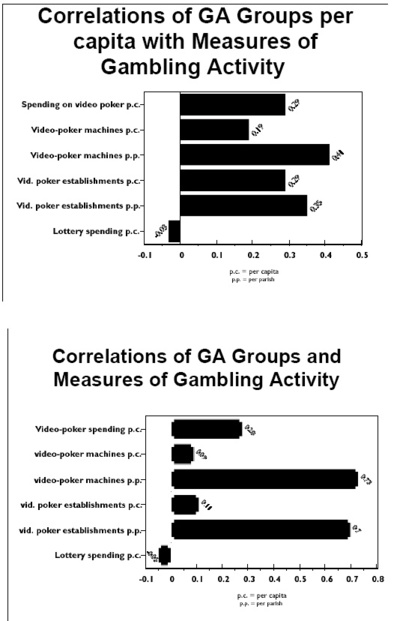The WAGER, Vol 4(10) – Opportunities Knock?
An increase in the number of gambling venues in a given area does not necessarily lead to an increase
in the prevalence of pathological gambling. If pathological gamblers participate solely in illicit gambling
activities, then it is possible that a doubling or even tripling of legal gambling opportunities would have little or no effect on prevalence. Campbell & Lester (1999) set out to investigate this matter by examining gambling in Louisiana. The authors chose the number of Gamblers Anonymous groups and groups per capita as their dependent variables, and parishes as their units of analysis. They limited their analysis to video poker, legal in Louisiana since June 1992, and the state lottery, legal since September 1991.
Per capita spending on video poker was mildly yet significantly correlated with the number of GA groups and GA groups per capita (respectively, Pearson’s r=.28, p=.023; Pearson’s r=.29, p=.019). Correlations of this magnitude explain only approximately 8% of the relationship. A small association was also found between GA groups per capita and the number of gambling establishments per capita (r=.29, p=.02). No correlations were found concerning lottery expenditure. 
The data provides evidence for a mild relationship between the number of GA groups (and GA groups per capita) and certain measures of gambling activity. However, the use of GA groups as a dependent variable may limit the usefulness of these findings. A large number of GA groups does not necessarily indicate a high prevalence of pathological gambling. It is possible that an area with an abnormally high prevalence of pathological gamblers will have no GA groups. Similarly, it is possible that an area with a relatively low number of pathological gamblers will have several groups. Thus, from the present data we do not have evidence for a relationship between the availability of gambling opportunities and high levels of gambling disorder, only a relationship between availability and GA groups. Nevertheless, if we accept the number of GA groups as an indicator of pathological gambling, then there is only weak support for a relationship between amount spent of gambling and prevalence of the disorder.
Source: Campbell, F. & Lester, D. (1999). The impact of gambling opportunities on compulsive gambling. The Journal of Social Psychology, 139(1), 126-127. .
This public education project is funded, in part, by The Andrews Foundation and the National Center for Responsible Gaming.